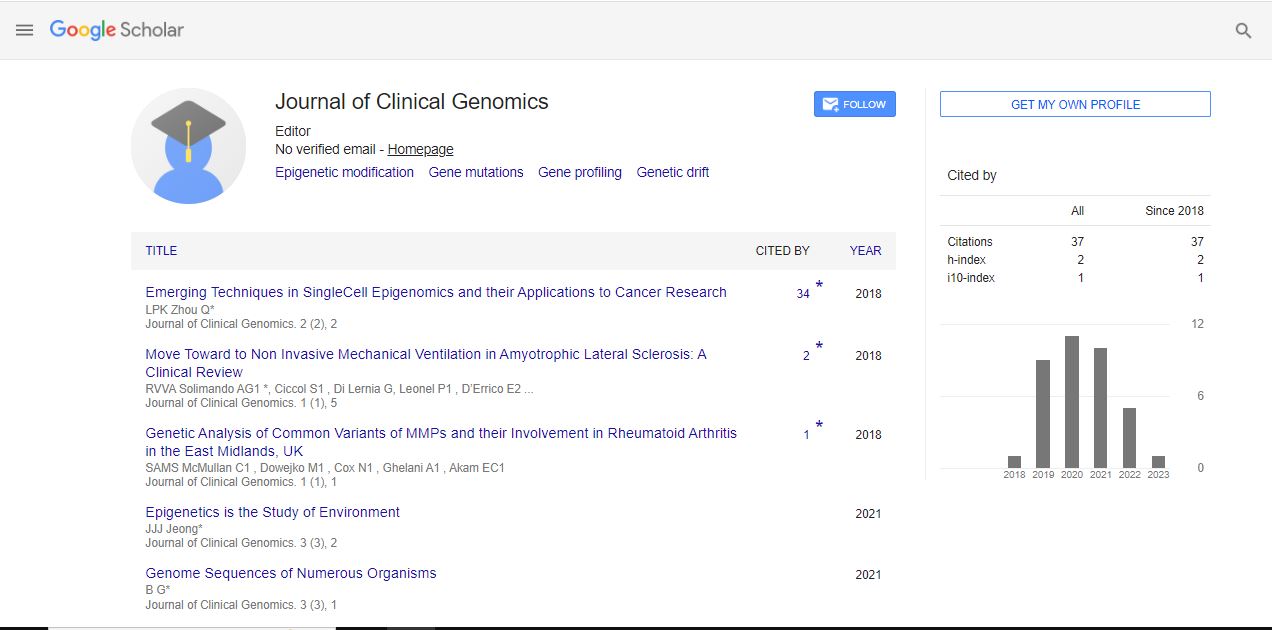Commentary, J Chromatography Res Vol: 6 Issue: 4
Stationary Phase Breakthroughs in Innovation for Chromatographic Techniques
Haulo Leitão*
1Department of Medicinal Chemistry and Pharmacognosy, University of Illinois, Chicago, USA
*Corresponding Author: Haulo Leitão,
Department of Medicinal Chemistry
and Pharmacognosy, University of Illinois, Chicago, USA
E-mail: Leitaopaulo45089@gmail.com
Received date: 27 November, 2023, Manuscript No. JCGR-24-123808;
Editor assigned date: 29 November, 2023, Pre QC No. JCGR-24-123808 (PQ);
Reviewed date: 14 December, 2023, QC No. JCGR-24-123808;
Revised date: 21 December, 2023, Manuscript No. JCGR-24-123808 (R);
Published date: 28 December, 2023, DOI: 10.36648/JCGR.1000073.
Citation: Leitão H (2023) Stationary Phase Breakthroughs in Innovation for Chromatographic Techniques. J Chromatography Res 6:4.
Description
Chromatography, a versatile separation technique, relies heavily on the properties of the stationary phase for successful analyte separation. The continuous quest for improved efficiency, selectivity, and sensitivity in chromatographic analyses has fueled research into the development of novel stationary phases. This essay explores the recent advancements in novel stationary phase development for chromatography, highlighting the significance of these innovations in diverse analytical applications. In chromatography, the stationary phase is a critical component that interacts with analytes to facilitate their separation. The choice of stationary phase influences the selectivity and efficiency of the chromatographic separation. Traditional stationary phases include silica-based materials for Liquid Chromatography (LC) and various solid supports for Gas Chromatography (GC). However, the demand for improved performance has driven the exploration of novel materials and structures.
Monolithic columns represent a departure from the traditional particulate-packed columns. These columns have a continuous, porous structure that allows for rapid mass transfer during the separation process. Monolithic stationary phases offer advantages such as reduced backpressure and enhanced separation efficiency. Silica-based monoliths have been widely explored, and recent developments include organic polymer-based monoliths for enhanced selectivity. The introduction of core-shell particles has revolutionized liquid chromatography. These particles have a solid core surrounded by a thin porous shell. Core-shell columns offer higher efficiency, improved resolution, and reduced analysis times compared to traditional fully porous particles. The development of Superficially Porous Particles (SPP) is a specific subtype of core-shell technology, providing a balance between efficiency and backpressure.
Molecularly imprinted polymers represent a novel class of stationary phases designed with specific binding sites for target molecules. These polymers are synthesized with the template molecule, resulting in selective recognition sites that mimic biological receptors. MIPs have been employed in LC for the separation of chiral compounds, pharmaceuticals, and environmental pollutants, demonstrating high selectivity and stability.
Hydrophilic Interaction Chromatography (HILIC) has gained prominence for the separation of polar and hydrophilic compounds. Novel stationary phases tailored for HILIC include zwitterionic materials, graphitized carbon, and mixed-mode phases. These developments expand the applicability of HILIC to a broader range of analytes, including peptides, saccharides, and polar metabolites.
In Gas Chromatography (GC), the stationary phase is typically coated onto the inner wall of a capillary column. Recent advancements in specialty bonded phases include the development of unique coatings such as ionic liquids, polymeric phases, and specialty siloxane phases. These phases offer improved selectivity for specific compound classes, enabling precise separations in complex mixtures.
Chemical Vapor Deposition (CVD) technology represents an innovative approach to coating stationary phases in capillary columns. In CVD, the stationary phase is deposited as a thin layer onto the column walls, resulting in improved reproducibility and stability. CVD columns offer enhanced thermal stability, making them suitable for high-temperature applications. Chiral separation is a critical aspect of chromatography, particularly in pharmaceutical and agrochemical industries. Novel chiral stationary phases with enhanced selectivity have been developed, including polysaccharide-based phases, macrocyclic antibiotics, and zwitterionic selectors. These advancements contribute to the efficient separation of enantiomers in complex mixtures.
The immobilization of enzymes as stationary phases in chromatographic columns has gained attention for bioanalytical applications. These enzyme-immobilized columns enable selective separation based on enzymatic reactions, providing insights into substrate specificity and facilitating the analysis of complex biological samples. The pharmaceutical industry benefits significantly from novel stationary phases in chromatography. Improved chiral separations, enhanced resolution, and faster analyses contribute to the development and quality control of pharmaceutical products. The use of MIPs in pharmaceutical analysis aids in the selective extraction and quantification of specific drug compounds.
Environmental monitoring involves the analysis of complex matrices containing various pollutants. Novel stationary phases, such as those used in HILIC and monolithic columns, are valuable for the separation of polar compounds and the efficient analysis of environmental contaminants, including pesticides, herbicides, and endocrine-disrupting compounds. The food and beverage industry relies on chromatography for quality control and authentication. Specialty phases, including those designed for HILIC and core-shell particles, enhance the separation of polar compounds in food samples. Chiral stationary phases are instrumental in the analysis of enantiomers in food additives and natural products.
 Spanish
Spanish  Chinese
Chinese  Russian
Russian  German
German  French
French  Japanese
Japanese  Portuguese
Portuguese  Hindi
Hindi 